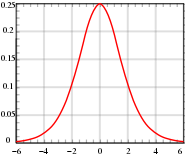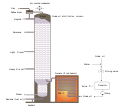Portal:Energy
| Main page | New articles & Tasks |
 The Energy Portal Welcome to Wikipedia's Energy portal, your gateway to energy. This portal is aimed at giving you access to all energy related topics in all of its forms.
|
Page contents: Selected article • Selected image • Selected biography • Did you know? • General images • Quotations • Related portals • Wikiprojects • Major topics • Categories • Help • Associated Wikimedia |
Introduction
In physics, energy (from Ancient Greek ἐνέργεια (enérgeia) 'activity') is the quantitative property that is transferred to a body or to a physical system, recognizable in the performance of work and in the form of heat and light. Energy is a conserved quantity—the law of conservation of energy states that energy can be converted in form, but not created or destroyed; matter and energy may also be converted to one another. The unit of measurement for energy in the International System of Units (SI) is the joule (J).
Common forms of energy include the kinetic energy of a moving object, the potential energy stored by an object (for instance due to its position in a field), the elastic energy stored in a solid object, chemical energy associated with chemical reactions, the radiant energy carried by electromagnetic radiation, and the internal energy contained within a thermodynamic system. All living organisms constantly take in and release energy.
Due to mass–energy equivalence, any object that has mass when stationary (called rest mass) also has an equivalent amount of energy whose form is called rest energy, and any additional energy (of any form) acquired by the object above that rest energy will increase the object's total mass just as it increases its total energy.
Human civilization requires energy to function, which it gets from energy resources such as fossil fuels, nuclear fuel, or renewable energy. The Earth's climate and ecosystems processes are driven by the energy the planet receives from the Sun (although a small amount is also contributed by geothermal energy). (Full article...)
Selected article
Iceland's location on the Mid-Atlantic Ridge makes it one of the most tectonically active places in the world, with over 200 volcanoes and over 20 high-temperature steam fields. Geothermal energy for heating was first used in 1907 when a farmer piped steam from a hot spring into his house. In 1930, the first pipeline was constructed in Reykjavík, heating two schools, 60 homes, and the main hospital. In 1943, the first geothermal district heating company started. Geothermal power now heats 89% of the nation's houses, provides around 19% of electricity generation and over 54% of primary energy. The first hydroelectric plant was built in 1904 and produced 9 kW of power. Hydropower now provides 81% of Iceland's electricity supply.
Imported oil provides most of Iceland's remaining energy. Replacing this with hydrogen was first suggested after the 1970s energy crisis, but the idea was not adopted until 1998. Iceland's small size makes it ideal for testing the viability of hydrogen as a fuel source for the future, while the plentiful renewable energy sources can be harnessed for its production. Iceland participates in international hydrogen fuel research and development programs, and many countries are following the nation's progress.
As a result of its transition to renewable energy, Iceland is ranked 53rd in the list of countries by carbon dioxide emissions per capita in 2003, emitting 62% less than the United States despite using more primary energy per capita.
Selected image

Photo credit: From an image by Arnold Paul
Coal-fired power stations transform chemical energy into 36%-48% electricity and 52%-64% waste heat.
Did you know?

- According to research by the IPCC, government funding for most energy research programmes has been flat or declining for nearly 20 years, and is now about half the 1980 level?
- Renewable energy in Iceland provides over 70% of the country's primary energy needs, and 99.9% of Iceland's electricity?
- The Rance tidal power plant in France was the world's 1st electrical generating station powered by tidal energy?
- A tropical cyclone (example pictured) can release heat energy at the rate of 50 to 200 trillion joules per day, roughly 200 times the world-wide electrical generating capacity?
- Ordinary fossil fuel power plants convert between 36% and 48% of the fuel's energy into electricity, with the remainder being lost as waste heat, about half of which is unavoidable due to the second law of thermodynamics?
- Burning biomass indoors leads to between 1.5 and 2 million deaths each year from indoor air pollution in developing nations?
- Over 50% of world small hydroelectricity generating capacity is in China?
- Charles Fritts developed the first solar cell in 1884, although its efficiency was less than 1%?
Selected biography
Born in Texas, Hubbert studied geology, mathematics, and physics at the University of Chicago. He pursued his Ph.D. while working for the Amerada Petroleum Company, then worked for the Shell Oil Company from 1943 until 1964. On leaving Shell he became a senior research geophysicist for the United States Geological Survey until retiring in 1976. Hubbert was also a professor at Stanford University and at UC Berkeley.
Hubbert is most well-known for his studies on the capacities of oil fields and natural gas reserves. He predicted that, for any given geographical area, the rate of petroleum production over time would resemble a bell curve. At the 1956 meeting of the American Petroleum Institute, Hubbert predicted that United States petroleum production would peak in the late 1960s or early 1970s. He became famous when his prediction came true in 1970.
In 1974, Hubbert projected that global oil production would peak in 1995 "if current trends continue". Various subsequent predictions have been made by others as trends have fluctuated in the intervening years. Hubbert's theory, and its implications for the world economy, remain controversial.
In the news
- 15 June 2024 – Russian invasion of Ukraine
- The United States announces a $1.5 billion aid package to Ukraine, focused primarily on the country's energy industry and humanitarian assistance. (Politico)
- 1 June 2024 – Russian invasion of Ukraine
- Russia launches missile and drone strikes across Ukraine, injuring at least four people and damaging critical infrastructure, including energy facilities. Ukraine says that it shot down 35 of 53 missiles and 46 of 47 drones. (Reuters)
General images
Quotations
- "My administration is committed to a leadership role on the issue of climate change. We recognize our responsibility and will meet it - at home, in our hemisphere, and in the world." – George W. Bush, 2001
- "While the Kyoto Protocol is a crucial step forward, that step is far too small. And as we consider how to go further still, there remains a frightening lack of leadership." – Kofi Annan, 2006
- "It is going to be very difficult to keep temperature increases down to between 2 and 3 degrees centigrade [3.6 - 5.4°F]. We should work very hard to do that." – Nicholas Stern, 2006
- "Halting global warming requires urgent, unprecedented international cooperation, but the needed actions are feasible and have additional benefits for human health, agriculture and the environment." – James E. Hansen, 2004
Related portals
WikiProjects
WikiProjects connected with energy:
Other WikiProjects that may be of interest:
Major topics
Major categories
National energy supply, use & conservation
National electricity sector
Politics, economics, environment
- Climate change
- Energy conservation
- Energy economics
- Energy crises
- Energy development
- Energy policy
- Peak oil
Energy sources
- Fuels
- Biofuels
- Fossil fuels
- Fusion power
- Nuclear technology
- Renewable energy
- Energy conversion
- Electric power
- Energy storage
Energy-related design
Scientific usage
Help

Puzzled by energy?
Can't answer your question?
Don't understand the answer?
- Ask at the reference desk
- Read the Wikipedia help pages
For further ideas, to leave a comment, or to learn how you can help improve and update this portal, see the talk page.
Associated Wikimedia
The following Wikimedia Foundation sister projects provide more on this subject:
-
Commons
Free media repository -
Wikibooks
Free textbooks and manuals -
Wikidata
Free knowledge base -
Wikinews
Free-content news -
Wikiquote
Collection of quotations -
Wikisource
Free-content library -
Wikiversity
Free learning tools -
Wiktionary
Dictionary and thesaurus





























































































































































































